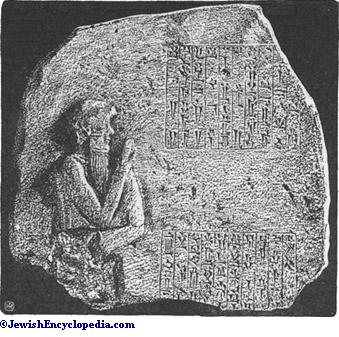Amram Ben Sheshna Or Shushna (Known As Amram Gaon Or Mar-Amram)
 From Jewish Encyclopedia (1906)
From Jewish Encyclopedia (1906) Amram Ben Sheshna Or Shushna (Known As Amram Gaon Or Mar-Amram):
By: Louis Ginzberg
Head of the Sura Academy; died about 875. He was a pupil of Naṭronai II., Gaon of Sura, and was exceptionally honored with the title of
Gaon
within the lifetime of his teacher. Upon Naṭronai's death, about 857, the full title and dignities of the gaonate were conferred upon Amram, and he held them until his death. He is the author of about 120 responsa (the greater part published in Salonica, 1792, in the collection entitled "Sha'are Ẓedeḳ") touching almost every department of Jewish jurisprudence. They are of great value in affording an insight into Amram's personality as well as into the religious conditions among the Jews of that period. The following decisions will serve in illustration: Interest may not be exacted even from non-Jews, nor even such minor profits as the Talmud designates as
 ("thedust of interest"), these being allowed only when customary in non-Jewish business circles ("Sha'are Ẓedeḳ," iv. 2, 20, 40). It is characteristic of Amram's method to avoid extreme rigor; thus he decides that a slave who has embraced Judaism, but desires to postpone the necessary circumcision until he feels strong enough for it, is not to be hurried (
ib.
iv. 6, 11). He combats superstition, and places himself almost in opposition to the Talmud, when he protests that there is no sense in fasting on account of bad dreams, since the true nature of dreams is not known (Ṭur, OraḦ Ḥayyim, § 568). Amram's rules concerning the methodology of the Talmud are of considerable value (Mueller, "MafteaḦ," p. 123).
("thedust of interest"), these being allowed only when customary in non-Jewish business circles ("Sha'are Ẓedeḳ," iv. 2, 20, 40). It is characteristic of Amram's method to avoid extreme rigor; thus he decides that a slave who has embraced Judaism, but desires to postpone the necessary circumcision until he feels strong enough for it, is not to be hurried (
ib.
iv. 6, 11). He combats superstition, and places himself almost in opposition to the Talmud, when he protests that there is no sense in fasting on account of bad dreams, since the true nature of dreams is not known (Ṭur, OraḦ Ḥayyim, § 568). Amram's rules concerning the methodology of the Talmud are of considerable value (Mueller, "MafteaḦ," p. 123).
But the most important work of Amram, which marks him as one of the most prominent of the geonim before Saadia, is his "Prayer-book," the so-called "Siddur Rab Amram." Amram was the first to arrange a complete liturgy for use in synagogue and home. His book forms the foundation both of the Spanish-Portuguese and of the German-Polish liturgies, and has exerted great influence upon Jewish religious practise and ceremonial for more than a thousand years, an influence which to some extent is still felt at the present day. For Amram did not content himself with giving the mere text of the prayers, but in a species of running commentary added very many Talmudical and gaonic regulations relating to them and their allied ceremonies. His "Prayer-book," which was made familiar by the many extracts quoted from it by the liturgical writers of the Middle Ages, and which served as the model for Saadia's and Maimonides' own prayer rituals, was published complete for the first time in Warsaw, in the year 6185, by N. N. Coronel, under the title, "Seder Rab Amram Gaon." The work as published is composed of two parts. The second part containing the seliḦot (propitiatory prayers) and pizmonim (liturgical poems) for the month of Elul, for New Year and the Day of Atonement, is certainly not the work of Amram, but appears to belong to a much later period. Even the first portion, which contains the prayers proper, is full of interpolations, some of which, as the "Ḳedushah" (Sanctification) for private prayer, are evidently later additions in the manuscripts. But not much weight can be attached even to portions of the book which are specifically given under the name of Amram; many of the explanations are certainly not by him, but by the academical copyists who appended his name to them, speaking of him in the third person. These explanations of the prayers make no reference to any authorities later than the following: Naṭronai II., Amram's teacher (17 times), Shalom, Naṭronai's predecessor in the gaonate (7 times), Judah, Paltoi, Zadok, and Moses, geonim before Amram (once each) Cohen Ẓedeḳ (twice), Nahshon and ẒemaḦ, contemporaries of Amram (twice each), and Nathan of unknown date. The only authority mentioned of later date than Amram is Saadia (p. 4 b ). This indicates that the additions to the text of the prayers must have originated in Amram's time. Certainty on this head, however, can only be obtained by a comparison of the printed text with the manuscripts; that of Almanzi, according to the specimens given by Luzzatto, varies considerably from the printed text. Israel ben Todros (1305) mentions some azharot as having been composed by Amram; but no trace of these can now be found (see Neubauer, in "Jew. Quart. Rev." vi. 703).

- Rapoport, Bikkure ha-'Ittim, x. (1829) 36, 37;
- Einleitung zum Parchon, xi. note;
- Reifmann, Zion, ii. 165;
- Luzzatto, in Literaturbl. d. Orients, viii. 290-297, 326-328;
- Steinschneider, Cat. Bodl. col. 2619;
- Grätz, Gesch. d. Juden, 2d ed., v. 249, 478;
- Joel Mueller, MafteaḦ, pp. 121-129, and Halakot Pesuḳot, p. 4;
- Is. Halevy, Dorot ha-Rishonim, pp. 243-259;
- I. H. Weiss, Dor, iv. 117-122.
Categories: [Jewish encyclopedia 1906]
↧ Download as ZWI file | Last modified: 09/04/2022 17:33:06 | 63 views
☰ Source: https://www.jewishencyclopedia.com/articles/1438-amram-ben-sheshna.html | License: Public domain
 ZWI signed:
ZWI signed: KSF
KSF